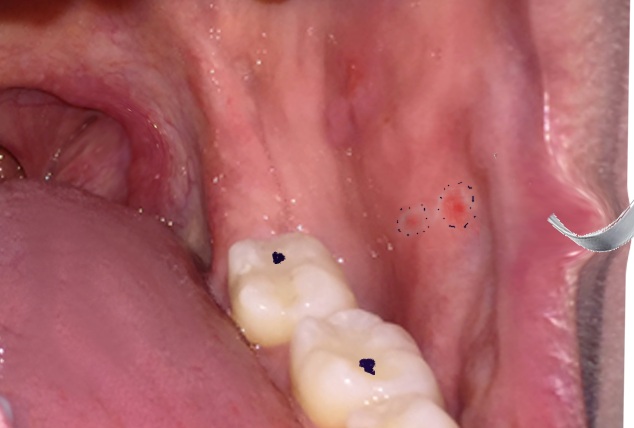Definition/Introduction
Koplik spots are the peculiar spots present on the buccal mucosa and are considered a diagnostic/pathognomic feature of measles/rubeola in the pre-eruptive stage. The term Koplik spot derives its name from Dr. Henry Koplik of New York, who first described them in 1896.
Issues of Concern
The appearance of Koplik spots in the mucosa is usually one day before the onset of rash. They appear as bluish-white spots, slightly raised with a diameter of approximately 2 to 3 mm on an erythematous base on the buccal mucosa opposite the first molar.[1][2] This characteristic appearance of Koplik spots is sometimes referred to as “grains of salt on a red background.” The bluish appearance is due to the collar of dilated veins around the submucosal gland duct, and the white portion is likely due to the destruction of cells of the glandular epithelium.[3] Occasionally, they may also appear in other areas such as the soft palate, conjunctival fold, and vaginal or intestinal mucosa and usually persist for 2 or 3 days.[2][4]
Reports indicate that Koplik spots appear in 60% to 70% of persons suffering from measles.[5] The height of the eruption takes place when the skin eruption appears and starts spreading. As the skin rash progresses, the spot on the mucosa loses its characteristic appearance and becomes discrete, resulting in a diffuse red background with numerous bluish-white specks randomly scattered on its surface. Ultimately, after a few days, the mucosa reverts to its normal appearance.
Differential diagnosis: This includes Fordyce granules (lack a bright red background), aphthous ulcers (painful and are less numerous), and parvovirus B19 infection.
Clinical Significance
Measles is among the leading causes of morbidity and mortality worldwide during childhood, particularly in developing countries. It is one of the most contagious diseases known that spreads through exposure to contaminated exposure or contact. The World Health Organisation has issued various vaccine strategies for the reduction of measles.[5] But there is decreased coverage in some countries due to economic and political issues and safety concerns about vaccines; this has led to a sharp increase in measles cases in these countries. Thus, early detection is a must and is a key to limit its spread. Koplik spots have not only a diagnostic significance, but also they are essential in controlling the outbreak of measles. If measles is diagnosed early via identification of Koplik spots, measures can be taken to limit the spread before reaching maximum infectivity. Thus, early identification dramatically aids in controlling this highly infectious disease by permitting prompt management and control measures for measles.[6]
Nursing, Allied Health, and Interprofessional Team Interventions
The nurse should be aware of the early symptoms of measles, such as Koplik spots, procedures to be done if the presence of measles is confirmed, and should know how to handle the patient. She should have a thorough knowledge of the disease and should be able to physically examine the child for symptoms of measles and assess the family’s hygiene practices to prevent the spread of the disease. The ability of the nurses to quickly assess the child with Koplik spots may save lives by decreasing the spread of this highly communicable disease (measles). Nurses should be aware of the current recommendations for vaccinations. In a child suffering from measles, nurse intervention is necessary for proper skin care, eye care, and hydration. Also, some patients chose not to vaccinate their children. In such cases, nursing intervention is necessary to educate the parents on the consequences of such a decision.

